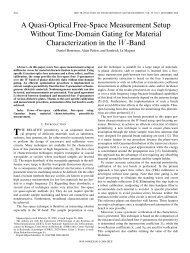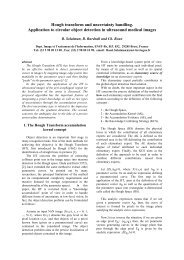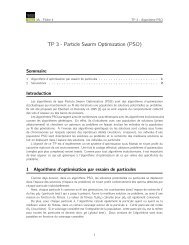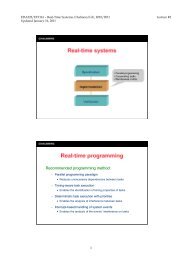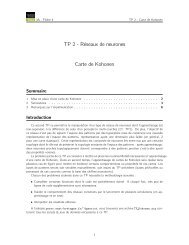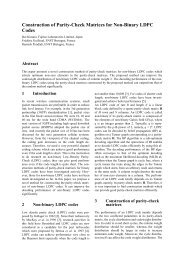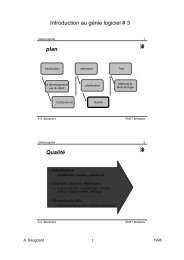Dynamic Data Replication and Consistency in Mobile Environments
Dynamic Data Replication and Consistency in Mobile Environments
Dynamic Data Replication and Consistency in Mobile Environments
Create successful ePaper yourself
Turn your PDF publications into a flip-book with our unique Google optimized e-Paper software.
stra<strong>in</strong>ts <strong>and</strong> objectives of each field.<br />
For fault-tolerant services, the appropriate system for achiev<strong>in</strong>g<br />
fault tolerance is the group communication system that<br />
is <strong>in</strong>troduced <strong>in</strong> [2](see also [3]). To ensure fault tolerance,<br />
the correctness criteria of l<strong>in</strong>earisability <strong>and</strong> sequential<br />
consistency must be satisfied. Two pr<strong>in</strong>cipal techniques<br />
are proposed <strong>in</strong> order to satisfy these constra<strong>in</strong>ts: passive<br />
replication <strong>and</strong> active replication [3] [8] [15] [18]. In passive<br />
replication, clients communicate with a primary replica<br />
that propagates update messages to other replicas. In active<br />
replication, clients communicate by multicast with all<br />
replicas. Other hybrid techniques like semi-active [9] <strong>and</strong><br />
semi-passive [4] replication comb<strong>in</strong>e the previous techniques.<br />
In the database field, the correctness criterion is one-copy<br />
serialisability [1] which means that an execution of a set of<br />
transactions on a replicated database is equivalent to a serial<br />
execution of these transactions on a non-replicated database.<br />
Several replication strategies are proposed <strong>in</strong> the literature<br />
to ensure this criterion. [7] [18] have categorised these<br />
strategies <strong>in</strong> four classes accord<strong>in</strong>g to: the update propagation<br />
approach <strong>and</strong> the update ownership approach. The<br />
propagation strategy can either be an eager propagation or a<br />
lazy propagation. In case of eager propagation, updates are<br />
applied to all replicas as part of one atomic transaction. In<br />
the lazy replication, the update messages are asynchronously<br />
propagated to other replicas after the transaction commit.<br />
The ownership strategy can be a master or a group ownership.<br />
In the former case, updates are first applied to the<br />
primary copy <strong>and</strong> then to other copies. In the latter case,<br />
any copy can update other replicas. Consequently, we can<br />
dist<strong>in</strong>guish four classes of replication strategies: eager group<br />
replication, eager master replication, lazy group replication,<br />
<strong>and</strong> lazy master replication.<br />
Some exist<strong>in</strong>g systems try to ensure a high data availability<br />
like Bayou <strong>and</strong> Coda, but these systems establish a weak<br />
data consistency. Bayou [5] is a mobile database replication<br />
platform on which developers can build collaborative<br />
applications. Bayou adopts a flexible replication strategy<br />
(read any/write any) that allows a user to access the data<br />
from any node. An anti-entropy protocol is used for update<br />
propagation between weakly consistent replicas. This<br />
protocol is based on pair-wise communication. Bayou allows<br />
the detection <strong>and</strong> the resolution of update conflicts <strong>in</strong><br />
an application-specific manner. In order to do this, dependency<br />
checks <strong>and</strong> merge procedures are used. Coda [12] [3]<br />
is a file system that replicates each file on a group of servers<br />
<strong>and</strong> manages the network disconnection. This allows a mobile<br />
user to work <strong>in</strong> disconnected mode by access<strong>in</strong>g a local<br />
cache. The replication strategy that is used <strong>in</strong> Coda is a<br />
variant of a read-one/write-all approach. Coda also allows<br />
the detection <strong>and</strong> the resolution of update conflicts by means<br />
of Coda version vector (CVV) <strong>and</strong> Coda repair tool.<br />
Some previous works on replication consider some environment<br />
parameters that are related to the system performance<br />
which may <strong>in</strong>deed be <strong>in</strong>fluenced by the change <strong>in</strong><br />
mobile environment resources. For example, the b<strong>and</strong>width<br />
degradation <strong>and</strong> the change <strong>in</strong> user location can considerably<br />
<strong>in</strong>crease the response time <strong>and</strong> the network overhead.<br />
Among these studies are [11] [10] that take <strong>in</strong>to account, at<br />
replica placement time, network topology <strong>in</strong>formation <strong>and</strong><br />
user location <strong>in</strong> order to reduce the client access latency<br />
<strong>and</strong> the network overhead. [19] propose a dynamic replication<br />
scheme which is based on users’ mobility schedules,<br />
access behavior <strong>and</strong> read/write patterns. [16] propose a<br />
generalized framework for replica host<strong>in</strong>g system that automatically<br />
adapts the replication scheme to variations <strong>in</strong><br />
some parameters which are related to the system performance<br />
<strong>and</strong> are classified as controllable <strong>and</strong> uncontrollable<br />
parameters. Controllable parameters are those whose value<br />
can be controlled by the system e.g, the number of replicas<br />
<strong>and</strong> their location. Uncontrollable parameters are those<br />
which cannot be directly controlled by the system like client<br />
request rates <strong>and</strong> update rates for Web documents. [17]<br />
propose replica creation <strong>in</strong> mobile devices to allow the operation<br />
<strong>in</strong> disconnected mode <strong>and</strong>/or to avoid the use of weak<br />
b<strong>and</strong>width l<strong>in</strong>ks.<br />
However, these works do not take <strong>in</strong>to account the nature<br />
of data. Indeed, accord<strong>in</strong>g to its nature, data may need a set<br />
of resources such as network b<strong>and</strong>width <strong>and</strong> storage space<br />
<strong>in</strong> order to be replicated. Other environment <strong>in</strong>formation<br />
like node security, device type <strong>and</strong> user activity may also<br />
be essential for replicat<strong>in</strong>g or perform<strong>in</strong>g any operation on<br />
this data. For example, for the bank<strong>in</strong>g application, data is<br />
confidential. That is, to create <strong>and</strong> place this data, we need<br />
a high security level for nodes <strong>and</strong> l<strong>in</strong>ks. The change <strong>in</strong> some<br />
of this <strong>in</strong>formation might not <strong>in</strong>fluence the performance of<br />
the system <strong>and</strong> the previous works cannot therefore provide<br />
a satisfy<strong>in</strong>g solution to replication.<br />
This limited context <strong>in</strong>formation management has motivated<br />
us to study this replication aspect. Thus, we propose a<br />
context-aware replication system, the architecture of which<br />
is presented <strong>in</strong> the follow<strong>in</strong>g section.<br />
3. EXPECTED CONTRIBUTION<br />
3.1 Execution context<br />
There are many def<strong>in</strong>itions of context. Among them,<br />
Schilit et al. [13] consider three important aspects of context:<br />
where you are, who you are with, <strong>and</strong> what resources are<br />
nearby. Context can thus <strong>in</strong>clude light<strong>in</strong>g, network connectivity,<br />
communication b<strong>and</strong>width, etc. Dey et al. [6] def<strong>in</strong>e<br />
the context as any <strong>in</strong>formation that can be used to characterise<br />
the situation of an entity. An entity is a person,<br />
place, or object that is considered relevant to the <strong>in</strong>teraction<br />
between a user <strong>and</strong> an application, <strong>in</strong>clud<strong>in</strong>g the user <strong>and</strong><br />
application themselves.<br />
Context <strong>in</strong>formation is first sensed by sensors. Next, it<br />
is h<strong>and</strong>led by a context-aware <strong>in</strong>frastructure [14] [6] that<br />
provides a high-level context <strong>in</strong>formation to an application.<br />
All of these steps are outside the scope of this paper.<br />
In our work, we need two types of context: required context<br />
<strong>and</strong> provided context.<br />
The required context consists of data constra<strong>in</strong>ts <strong>and</strong> user<br />
preferences. Accord<strong>in</strong>g to its nature, data may need a set of<br />
resources like storage space <strong>and</strong> b<strong>and</strong>width. So, the application<br />
designer def<strong>in</strong>es a set of constra<strong>in</strong>ts that have to be<br />
satisfied <strong>in</strong> order to create data replicas or perform any operation<br />
on these replicas such as read/write operations <strong>and</strong><br />
consistency.<br />
The provided context consists of all software properties<br />
such as the operat<strong>in</strong>g system <strong>and</strong> programm<strong>in</strong>g language,<br />
hardware properties like available processors <strong>and</strong> storage<br />
space, <strong>and</strong> physical environment properties like meet<strong>in</strong>g room<br />
state. This type of context may also <strong>in</strong>clude the user profile,<br />
like his location <strong>and</strong> daily activities.<br />
Our replication system takes <strong>in</strong>to account this <strong>in</strong>formation



